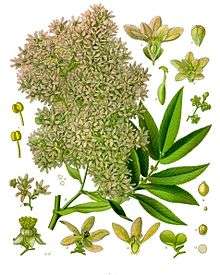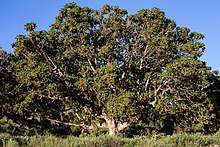Hagenia
Hagenia abyssinica is a species of flowering plant native to the high-elevation Afromontane regions of central and eastern Africa. It also has a disjunct distribution in the high mountains of East Africa from Sudan and Ethiopia in the north, through Kenya, Uganda, Rwanda, Burundi, Democratic Republic of Congo, and Tanzania, to Malawi and Zambia in the south.
| Hagenia | |
|---|---|
 | |
| Hagenia abyssinica | |
| Scientific classification | |
| Kingdom: | Plantae |
| Clade: | Tracheophytes |
| Clade: | Angiosperms |
| Clade: | Eudicots |
| Clade: | Rosids |
| Order: | Rosales |
| Family: | Rosaceae |
| Subfamily: | Rosoideae |
| Tribe: | Sanguisorbeae |
| Subtribe: | Agrimoniinae |
| Genus: | Hagenia J.F.Gmel. |
| Species: | H. abyssinica |
| Binomial name | |
| Hagenia abyssinica Willd. | |
Description

It is known in English as African redwood, East African rosewood,[1] brayera, cusso, hagenia, or kousso, in Amharic as kosso, and in Swahili as mdobore or mlozilozi. It is the sole species of genus Hagenia, and its closest relative is the Afromontane genus Leucosidea. Synonyms include Banksia abyssinica, Brayera anthelmintica, Hagenia abyssinica var. viridifolia and Hagenia anthelmintica.
It is a tree up to 20 m in height, with a short trunk, thick branches, and thick, peeling bark. The leaves are up to 40 cm long, compound with 7-13 leaflets, each leaflet about 10 cm long with a finely serrated margin, green above, silvery-haired below. The flowers are white to orange-buff or pinkish-red, produced in panicles 30–60 cm long.
It is generally found from 2000–3000 m elevation, in areas receiving 1000–1500 mm of rainfall annually. It can be found growing in mixed afromontane forest with Podocarpus, Afrocarpus, and other trees, and in drier afromontane forests and woodlands where Hagenia is dominant, or in mixed stands of Hagenia and Juniperus procera. It is often found near the upper limit of forest growth, giving way to giant heather zones above it.
Hagenia is used as a food plant by the larvae of some Lepidoptera species including turnip moth.
Medicinal uses
Kosso, kousso or cusso is a drug which consists of the panicles of the pistillate flowers of Hagenia. At the time of the eleventh edition of the Encyclopædia Britannica (1911), the drug was imported "in the form of cylindrical rolls, about 18 inches in length and 2 inches in diameter, and comprises the entire inflorescence or panicle kept in form by a band wound transversely round it." The active principle is koussin or kosin, C31H33O10, which is soluble in alcohol and alkalis, and may be given in doses of two grammes. Kosso is also used in the form of an unstrained infusion of the coarsely powdered flowers, which are swallowed with the liquid. It is considered to be an effective anthelmintic for pork tapeworm (Taenia solium). In its anthelmintic action it is similar to Male Fern (Dryopteris filix-mas).
Use of Kosso was borrowed from Ethiopia, where as Richard Pankhurst quotes Merab as saying that "to mention it was to cover a quarter of that country's pharmacopeia."[2] However, its primary use was, well into the 19th century, to combat human tapeworm infestations, which was endemic due to widespread consumption of dishes containing raw beef, such as kitfo and gored gored. Frequent doses of kosso, about once every two months, was the common cure. Richard Pankhurst cites numerous examples of this practice, noting that "the two-monthly event virtually constituted a holiday for the patient, who withdrew from all normal activity, the statement 'the master has taken his kosso,' being synonymous with 'he cannot receive you today.' Kosso-drinking in fact served as an excuse or justification for not keeping appointments, being used by the debtor who did not wish to meet his creditor, by the accused who wished to avoid going to court, and by the official who sought to delay answering the Emperor's summons."[3]
Kosso or ኮሶ in Amharic is also the name of the human tapeworm, Taenia saginata.
Other uses
In Tanzania, the wood of Hagenia abyssinica is used extensively as fuel, the leaves as fodder, and its seeds as a condiment or spice. In the Kilimanjaro area, the bark of the tree has been used for dyeing textiles yellowish red.
Notes
- Bruijnzeel, L.A.; F. N. Scatena; L. S. Hamilton (2010). Tropical Montane Cloud Forests: Science for Conservation and Management. Cambridge: Cambridge University Press. p. 137. ISBN 9780521760355.
- Richard Pankhurst, An Introduction to the Medical History of Ethiopia (Trenton: Red Sea Press, 1990), p. 104
- Richard Pankhurst, Economic History of Ethiopia (Addis Ababa: Haile Selassie I University, 1968), p. 631.
Further reading
- Eriksson, T., Hibbs, M. S., Yoder, A. D., Delwiche, C. F., & Donoghue, M. J. (2003). The Phylogeny of Rosoideae (Rosaceae) Based on Sequences of the Internal Transcribed Spacers (ITS) of Nuclear Ribosomal DNA and the TRNL/F Region of Chloroplast DNA. International Journal of Plant Sciences 164(2): 197–211 (PDF version).

External links
- Hagenia abyssinica at the AgroForestry Tree Database (World Agroforestry Centre)
- "The Kosso Tree" is a watercolor by William Simpson from 1868
- Dressler, S.; Schmidt, M. & Zizka, G. (2014). "Hagenia". African plants – a Photo Guide. Frankfurt/Main: Forschungsinstitut Senckenberg.